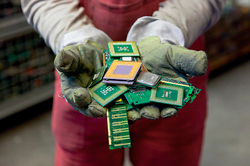 According to the UN report, in just 1 year worldwide in the debris was sent to more than 41 million tons of electronics. Total price contained in the volume of waste materials is estimated at $ 52 billion. According to the UN report, in just 1 year worldwide in the debris was sent to more than 41 million tons of electronics. Total price contained in the volume of waste materials is estimated at $ 52 billion.
Some large providers, likewise as their colleagues with less turnover, for some reason neglect the chance to recycle waste by sending them to a landfill without further treatment. This not only harms the environment, but also leads to specific material losses.
So, according to the UN study for 1 year in the world was thrown over 41 million tonnes of waste electronic and electrical products. With all this recycling has been only 15%, while the overall price of all useful materials, sent to the trash, reaches, according to unconfirmed estimates, $ 52 billion.
Electronic waste, or as it is also called e-waste contains precious and rare earth metals. But to remove them is quite labor intensive, and in makeshift conditions in addition to unsafe process. In this regard, many faced with the problem of disposal of obsolete equipment, do not wish to burden themselves with additional difficulties, and send it to the dump.
Thus in the garbage turned out to be 16 million tons of iron, 1.9 million tons of copper, 300 tons of gold and other materials of high value, such as, for example, palladium, reports "bi-Bi-si". Due to the fact that from year to year elektrotehnicheskaja products is becoming more difficult, but at the same time with this, and nedolgovechnoi, the volume of such waste will only grow.
Champions e musora UN experts have been recognized by the United States (slightly more than 7 million tons of waste). In second place was China (about 6 million tons), on the 3rd-Japan (2.2 million tons). European powers headed the rating of the volume of debris that is generated based on the number of population. So, in Norway on the 1st inhabitant accounted for 28.4 kg. of technical garbage.
sections: Economics
|